Fattorini H.O., Kerber A. The Cauchy Problem
Подождите немного. Документ загружается.

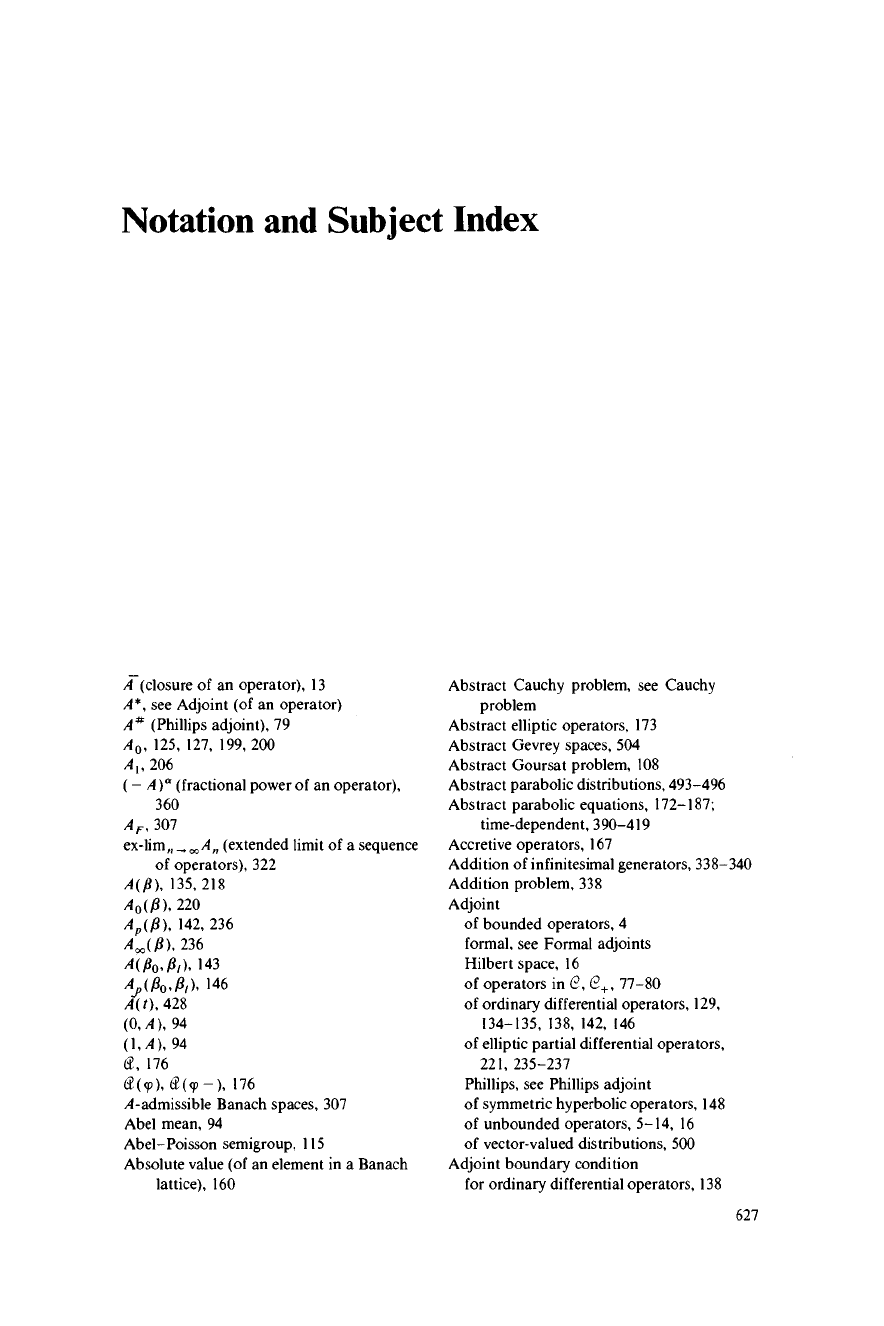
Notation and Subject Index
4 -(closure of an operator), 13
A*, see Adjoint (of an operator)
A" (Phillips adjoint), 79
Ao, 125, 127, 199, 200
A, 206
(
A)* (fractional power of an operator),
360
AF, 307
A,, (extended limit of a sequence
of operators), 322
A(#), 135, 218
Ao(/3), 220
A,($), 142, 236
236
A($o,/3,), 143
146
A(t), 428
(0, A), 94
(1, A), 94
(T, 176
d(9p), ?(4p-), 176
A-admissible Banach spaces, 307
Abel mean, 94
Abel-Poisson semigroup, 115
Absolute value (of an element in a Banach
lattice), 160
Abstract Cauchy problem, see Cauchy
problem
Abstract elliptic operators, 173
Abstract Gevrey spaces, 504
Abstract Goursat problem, 108
Abstract parabolic distributions, 493-496
Abstract parabolic equations, 172-187;
time-dependent, 390-419
Accretive operators, 167
Addition of infinitesimal generators, 338-340
Addition problem, 338
Adjoint
of bounded operators, 4
formal, see Formal adjoints
Hilbert space, 16
of operators in (2, C, 77-80
of ordinary differential operators, 129,
134-135,138,142,146
of elliptic partial differential operators,
221, 235-237
Phillips, see Phillips adjoint
of symmetric hyperbolic operators, 148
of unbounded operators, 5-14, 16
of vector-valued distributions, 500
Adjoint boundary condition
for ordinary differential operators, 138
627
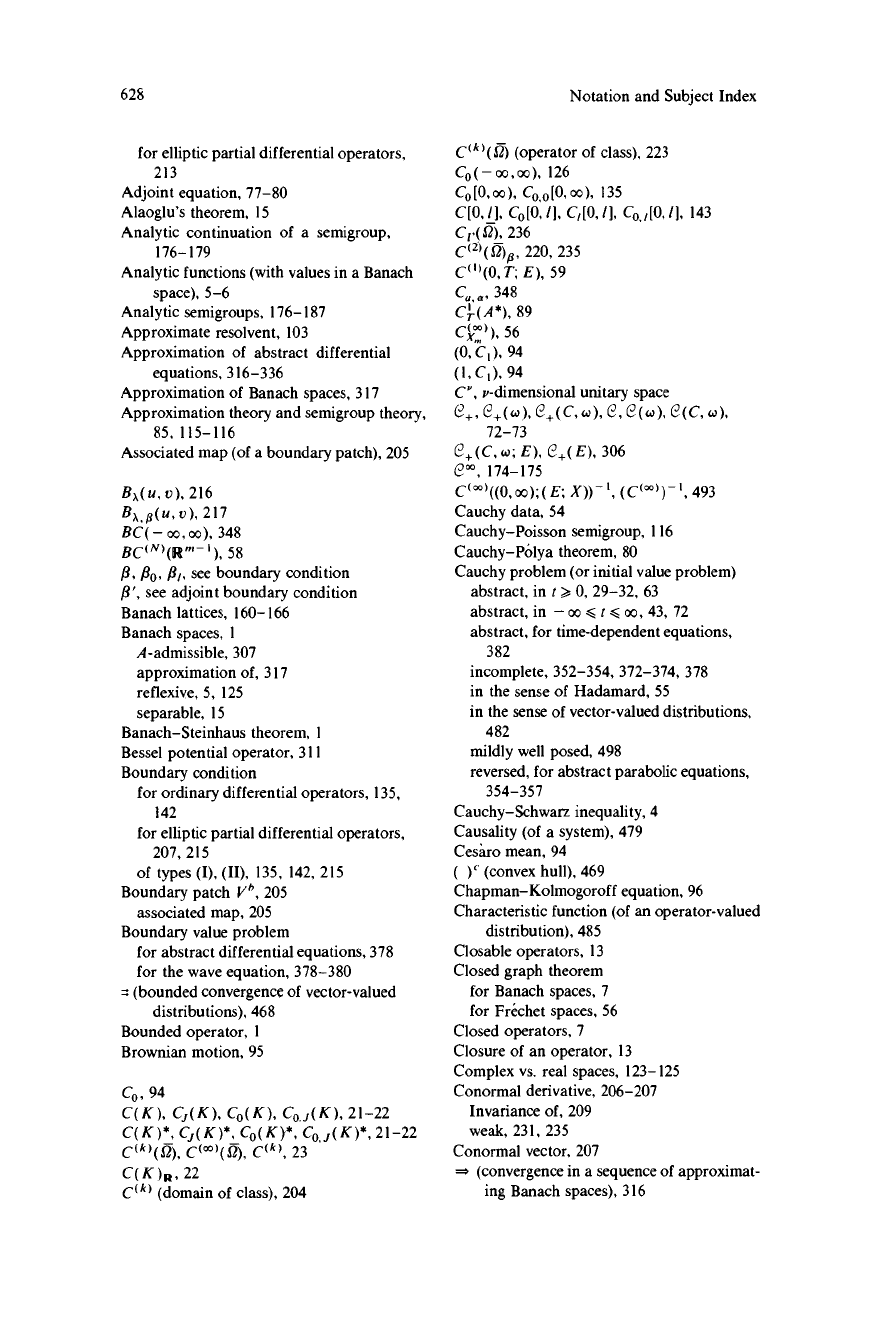
628
for elliptic partial differential operators,
213
Adjoint equation, 77-80
Alaoglu's theorem, 15
Analytic continuation of a semigroup,
176-179
Analytic functions (with values in a Banach
space), 5-6
Analytic semigroups, 176-187
Approximate resolvent, 103
Approximation of abstract differential
equations, 316-336
Approximation of Banach spaces, 317
Approximation theory and semigroup theory,
85, 115-116
Associated map (of a boundary patch), 205
Bx(u, v), 216
BA,fl(u,v), 217
BC(-oo,oo), 348
BC (N )(R--'), 58
/3, $o, /3,, see boundary condition
/3', see adjoint boundary condition
Banach lattices, 160-166
Banach spaces, I
A-admissible, 307
approximation of, 317
reflexive, 5, 125
separable, 15
Banach-Steinhaus theorem, I
Bessel potential operator, 311
Boundary condition
for ordinary differential operators, 135,
142
for elliptic partial differential operators,
207, 215
of types (1), (II), 135, 142, 215
Boundary patch V°, 205
associated map, 205
Boundary value problem
for abstract differential equations, 378
for the wave equation, 378-380
= (bounded convergence of vector-valued
distributions), 468
Bounded operator, I
Brownian motion, 95
Co, 94
C(K),
Co(K),
21-22
C(K)*, CO(K)*,
21-22
C(k)(ff), C(°o)(2), C(k) 23
C(K)R, 22
C(k) (domain of class), 204
Notation and Subject Index
C(k'(12) (operator of class), 223
Co(-oo,oo), 126
CB[O,oo), Co,0[0,oo), 135
C [0,1 ], Co [0,1 ], C, [0,1 ], Co,, [0, 1], 143
236
C(
z)(Q)fl, 220, 235
C(')(0, T; E), 59
Cam, a, 348
CT(A*), 89
Cj )), 56
(0, CI), 94
(1, C,), 94
C v-dimensional unitary space
L+, (2+(w), (2,(C, w), (2, L'(w), (2(C, w),
72-73
C'+(C, co; E), C'+(E), 306
C°°, 174-175
C (°°) ((0, oo); ( E; X))-',
493
Cauchy data, 54
Cauchy-Poisson semigroup, 1 16
Cauchy-Polya theorem, 80
Cauchy problem (or initial value problem)
abstract, in t
' 0, 29-32, 63
abstract, in - oo < t 5 cc, 43, 72
abstract, for time-dependent equations,
382
incomplete, 352-354, 372-374, 378
in the sense of Hadamard, 55
in the sense of vector-valued distributions,
482
mildly well posed, 498
reversed, for abstract parabolic equations,
354-357
Cauchy-Schwarz inequality, 4
Causality (of a system), 479
Cesaro mean, 94
( )` (convex hull), 469
Chapman-Kolmogoroff equation, 96
Characteristic function (of an operator-valued
distribution), 485
Closable operators, 13
Closed graph theorem
for Banach spaces, 7
for Frechet spaces, 56
Closed operators, 7
Closure of an operator, 13
Complex vs. real spaces, 123-125
Conormal derivative, 206-207
Invariance of, 209
weak, 231, 235
Conormal vector, 207
(convergence in a sequence of approximat-
ing Banach spaces), 316
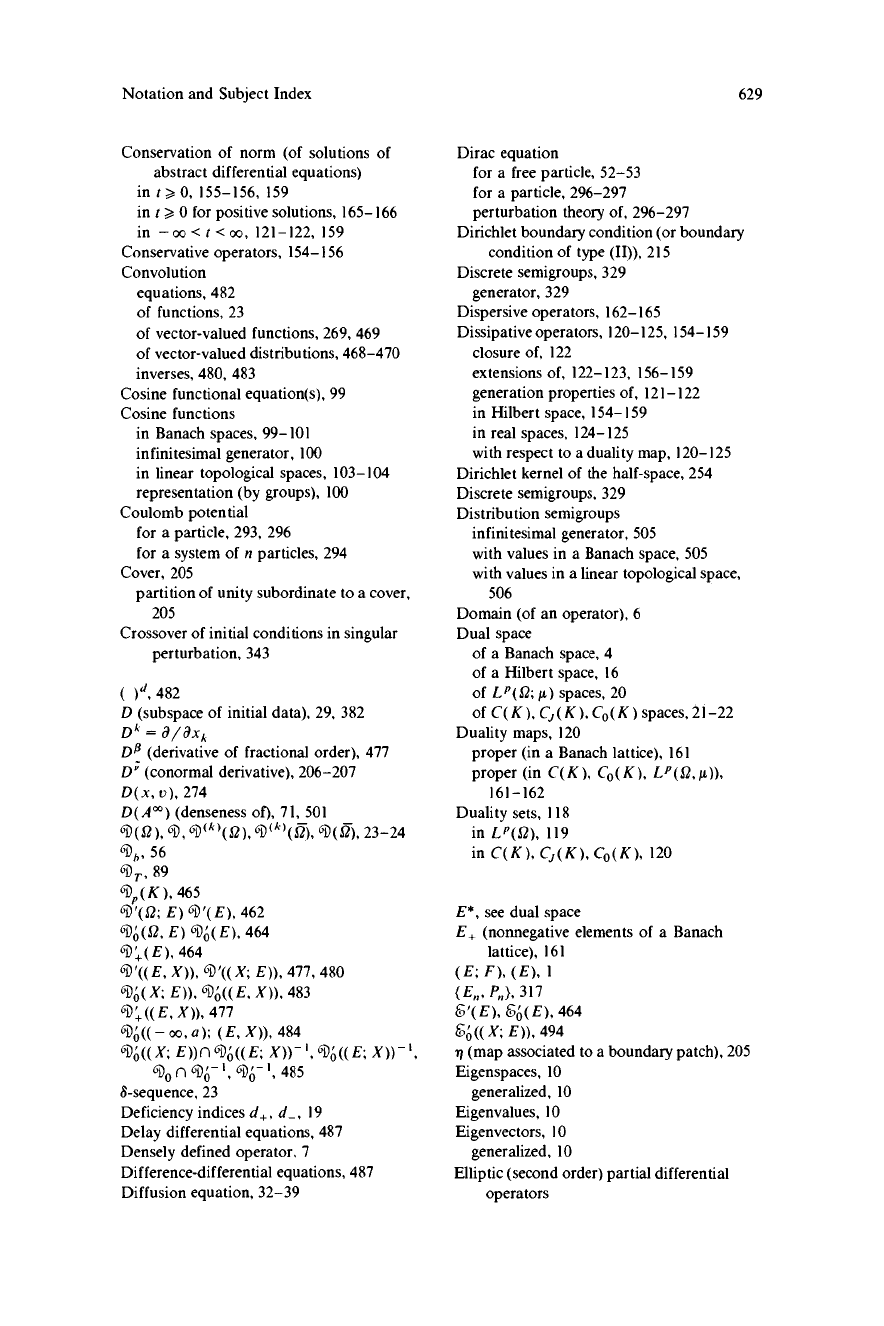
Notation and Subject Index
Conservation of norm (of solutions of
abstract differential equations)
in t > 0, 155-156, 159
in t > 0 for positive solutions, 165-166
in -oo<t<oo, 121-122, 159
Conservative operators, 154-156
Convolution
equations, 482
of functions, 23
of vector-valued functions, 269, 469
of vector-valued distributions, 468-470
inverses, 480, 483
Cosine functional equation(s), 99
Cosine functions
in Banach spaces, 99-101
infinitesimal generator, 100
in linear topological spaces, 103-104
representation (by groups), 100
Coulomb potential
for a particle, 293, 296
for a system of n particles, 294
Cover, 205
partition of unity subordinate to a cover,
205
Crossover of initial conditions in singular
perturbation, 343
( )a, 482
D (subspace of initial data), 29, 382
Dk = dldxk
Ds (derivative of fractional order), 477
D' (conormal derivative), 206-207
D(x, v), 274
D(A°°) (denseness of), 71, 501
6(S2),6
6D(k)(f2),6(k)(q),6
(9),23-24
6D,, 56
6D,, 89
%(K), 465
l '(Q; E) 6t '(E), 462
6o(Q, E) 6l o(E), 464
6D', ( E), 464
6 '((E, X)), 6D'((X; E)), 477, 480
6DO' (X; E)), 6D ()((E, X)), 483
6 +((E, X)), 477
6lo((-oo,a);
(E, X)),
484
6o((X; E))n 6lo((E; X))-', D ((E; X))-',
6i o n 6D L-', 'Dp-', 485
8-sequence, 23
Deficiency indices d, d-, 19
Delay differential equations, 487
Densely defined operator, 7
Difference-differential equations, 487
Diffusion equation, 32-39
629
Dirac equation
for a free particle, 52-53
for a particle, 296-297
perturbation theory of, 296-297
Dirichlet boundary condition (or boundary
condition of type (II)), 215
Discrete semigroups, 329
generator, 329
Dispersive operators, 162-165
Dissipative operators, 120-125, 154-159
closure of, 122
extensions of, 122-123, 156-159
generation properties of, 121-122
in Hilbert space, 154-159
in real spaces, 124-125
with respect to a duality map, 120-125
Dirichlet kernel of the half-space, 254
Discrete semigroups, 329
Distribution semigroups
infinitesimal generator, 505
with values in a Banach space, 505
with values in a linear topological space,
506
Domain (of an operator), 6
Dual space
of a Banach space, 4
of a Hilbert space, 16
of LP(S2; µ) spaces, 20
of C(K), Cj(K ), Co (K) spaces, 21-22
Duality maps, 120
proper (in a Banach lattice), 161
proper (in C(K), C0(K), LP(Q, p)),
161-162
Duality sets, 118
in LP(f ), 119
in C(K), Cj(K), C0(K), 120
E*, see dual space
E+ (nonnegative elements of a Banach
lattice), 161
(E; F), (E), I
(E,,, 317
&'(E), 6;o(E), 464
&o((X; E)), 494
r1(map associated to a boundary patch), 205
Eigenspaces, 10
generalized, 10
Eigenvalues, 10
Eigenvectors, 10
generalized, 10
Elliptic (second order) partial differential
operators
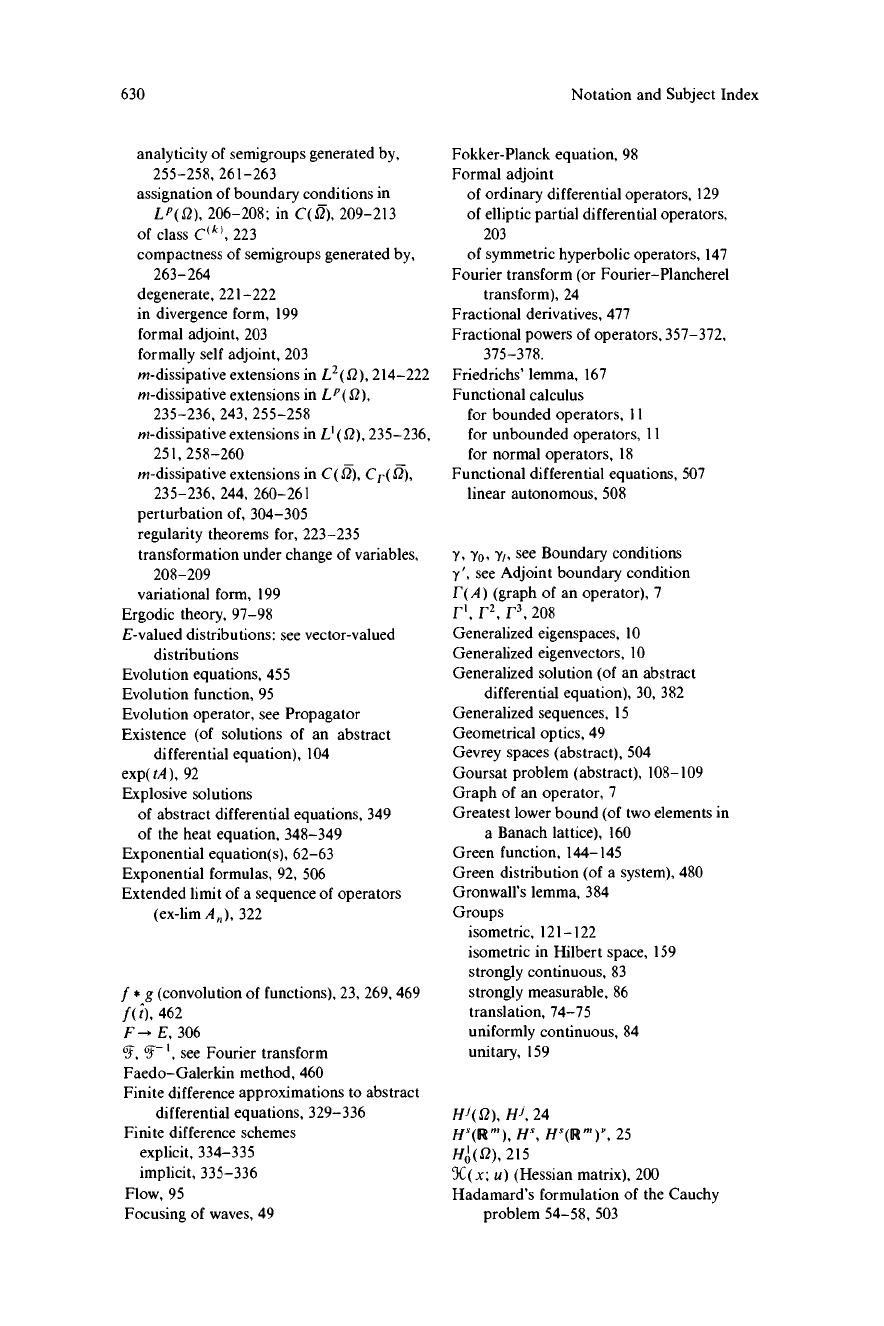
630
analyticity of semigroups generated by,
255-258, 261-263
assignation of boundary conditions in
LP(R), 206-208; in C(S2), 209-213
of class C(k), 223
compactness of semigroups generated by,
263-264
degenerate, 221-222
in divergence form, 199
formal adjoint, 203
formally self adjoint, 203
m-dissipative extensions in L2(Q), 214-222
m-dissipative extensions in LP(Q),
235-236, 243, 255-258
m-dissipative extensions in L' (T2), 235-236,
251, 258-260
m-dissipative extensions in C(S2), Cp(Q),
235-236, 244, 260-261
perturbation of, 304-305
regularity theorems for, 223-235
transformation under change of variables,
208-209
variational form, 199
Ergodic theory, 97-98
E-valued distributions: see vector-valued
distributions
Evolution equations, 455
Evolution function, 95
Evolution operator, see Propagator
Existence (of solutions of an abstract
differential equation), 104
exp(tA ), 92
Explosive solutions
of abstract differential equations, 349
of the heat equation, 348-349
Exponential equation(s), 62-63
Exponential formulas, 92, 506
Extended limit of a sequence of operators
(ex-lim
322
f * g (convolution of functions), 23, 269, 469
f(t), 462
F- E, 306
9, 6S-', see Fourier transform
Faedo-Galerkin method, 460
Finite difference approximations to abstract
differential equations, 329-336
Finite difference schemes
explicit, 334-335
implicit, 335-336
Flow, 95
Focusing of waves, 49
Notation and Subject Index
Fokker-Planck equation, 98
Formal adjoint
of ordinary differential operators, 129
of elliptic partial differential operators,
203
of symmetric hyperbolic operators, 147
Fourier transform (or Fourier-Plancherel
transform), 24
Fractional derivatives, 477
Fractional powers of operators, 357-372,
375-378.
Friedrichs' lemma, 167
Functional calculus
for bounded operators, II
for unbounded operators, I I
for normal operators, 18
Functional differential equations, 507
linear autonomous, 508
y, yo, y,, see Boundary conditions
y', see Adjoint boundary condition
F(A) (graph of an operator), 7
F', F2, F3, 208
Generalized eigenspaces, 10
Generalized eigenvectors, 10
Generalized solution (of an abstract
differential equation), 30, 382
Generalized sequences, 15
Geometrical optics, 49
Gevrey spaces (abstract), 504
Goursat problem (abstract), 108-109
Graph of an operator, 7
Greatest lower bound (of two elements in
a Banach lattice), 160
Green function, 144-145
Green distribution (of a system), 480
Gronwall's lemma, 384
Groups
isometric, 121-122
isometric in Hilbert space, 159
strongly continuous, 83
strongly measurable, 86
translation, 74-75
uniformly continuous, 84
unitary, 159
HJ(f2), Hi, 24
H'(R"') H',
H'(R'")o, 25
Ho(?), 215
`3C(x; u) (Hessian matrix), 200
Hadamard's formulation of the Cauchy
problem 54-58, 503

Notation and Subject Index
Heat-diffusion equation, 27-29, 32-39,
348-354
analyticity of solutions, 37
compactness of solution operator, 37
conservation of L'-norm of nonnegative
solutions, 38
explosive solutions, 348
in Ce(ll), 27-29
in LP(Q), 32-39
nonuniqueness of solutions, 349
reversed Cauchy problem, 350-354
Hereditary differential equations, 507
Hessian matrix, 200
Higher order abstract differential equations,
98-102
reduction to first order, 98, 101, 103
Hilbert spaces, I
Hilbert space adjoints, 16
Hille-Yosida theorem, 82-83, 91
Hille approximation, 92
Hyperfunctions, 505
Histories (spaces of), 508-509
Huygens' principle, 94-95, 507
l (space of inputs of a system), 479
(x) (incoming vectors for neutron transport
equation), 273
Inclusion of operators, 14
Incomplete Cauchy problem
for the Laplace equation, 352-354
for abstract differential equations, 372-374
Infinitesimal generator
of a semigroup, 81
of a distribution semigroup, 505
of a cosine function, 100
Inhomogeneous abstract differential
equations
time-independent, 86-91, 111-112
time-dependent, 415-419, 452-454
Impulsive excitation, 480
Input (of a system), 479
Ihtegral equations (for construction of the
propagator), 391
Integro-differential equations, 507
Integration (of functions with values in a
Banach space), 3-4
Interior patch V', 205
Invertible operators, 2
Joint graph norm, 486
J (mollifier operators), 23
LP(l2 A), LP(Q), LP(ll: µ)', LP(Q)°, 20
LP(K;µ)c, LP(12;µ)a, 22
631
LP(Q; µ)", 20
L P(2), 25
LP(F), 219
L2(IX'), L2(R
), 25
LP(Q)p, LP(Q)p, 258-259
LP(0,1)p, LP(0,1)p, 193
1f(X) (Laplace transform of a vector-valued
function), 31
LU(A) (Laplace transform of a vector-valued
distribution), 473
A( a, ft), A (logarithmic region), 487
Lagrange identity, 129, 138, 148, 203, 213
Lagrange formula, 87
Laplace transform
of vector-valued functions, 31
of vector-valued distributions, 473
Lattice, 160
Lax equivalence theorem, 337
Lax-Milgram lemma, 214, 460
Least upper bound (of two elements in a
Banach lattice), 160
Left (product) integral, 456
Lie's exponential formula, 338
Limit circle, 168
Limit point, 168
Linear functionals, 4
Logarithmic convexity, 375-376
Logarithmic region, 487
Lyapunov's theorem, 166
m (u), 126, 200
m-dissipative operators, 123
Markov processes, 95-98
Chapman-Kolmogorov equation, 96
Fokker-Planck equation, 98
temporally homogeneous, 96
transition probability, 96
Maximal dissipative operators, 156-158
Maximal symmetric operators, 19, 158-159
Maxwell equations, 43-49
conservation of norm of solutions, 45
focusing of waves, 49
in L2(i83)6, 44-45
in LP(R3)6, 45-48
in Co(R3)6 48-49
time-reversibility, 45
Method of lines, 325
Mollifiers, 23
Mollifying sequence, 23
Mild solution (of an abstract differential
equation), 88
Modulus (of an element in a Banach lattice),
160
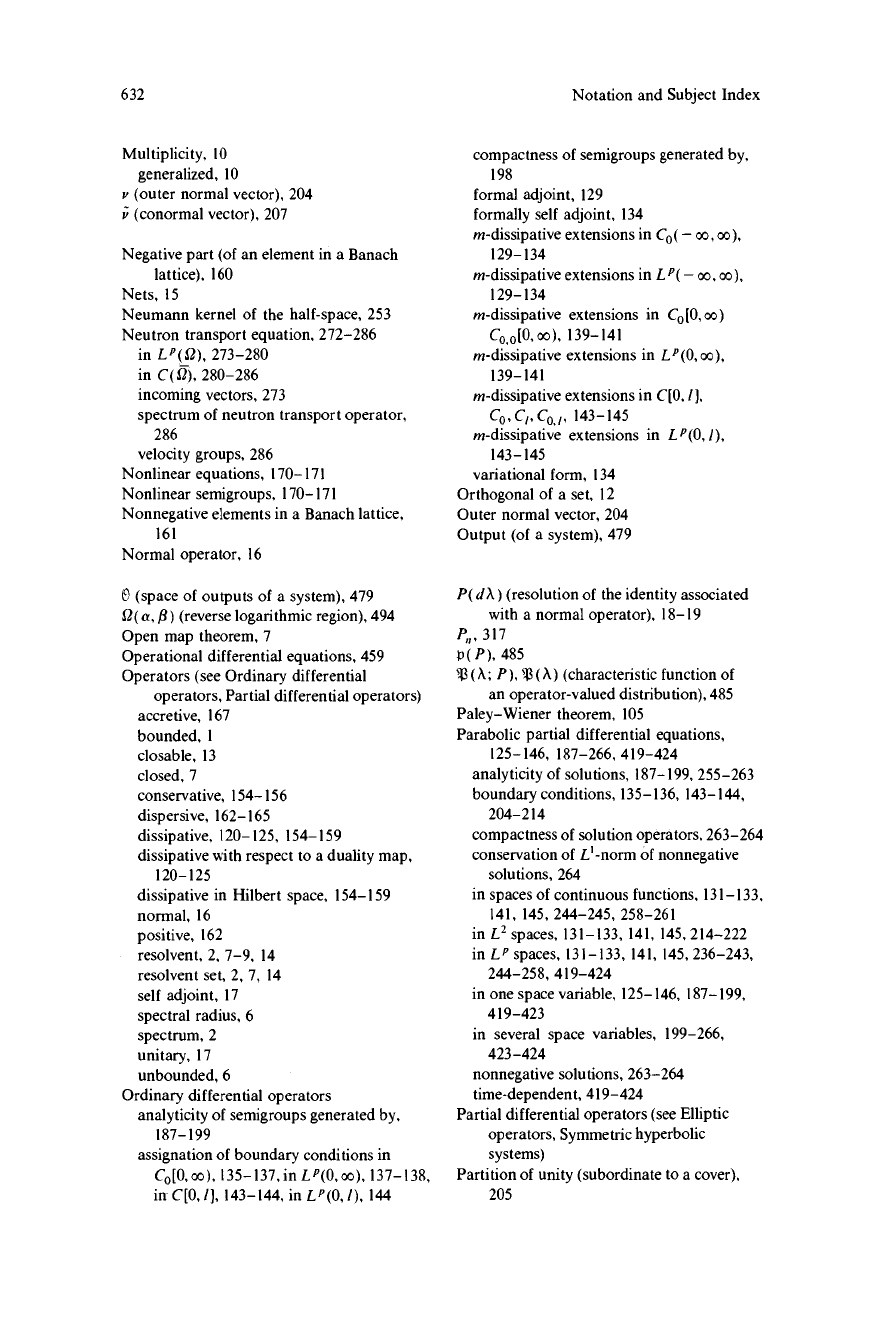
632
Multiplicity, 10
generalized, 10
v (outer normal vector), 204
v (conormal vector), 207
Negative part (of an element in a Banach
lattice), 160
Nets, 15
Neumann kernel of the half-space, 253
Neutron transport equation, 272-286
in LP(2), 273-280
in C(U), 280-286
incoming vectors, 273
spectrum of neutron transport operator,
286
velocity groups, 286
Nonlinear equations, 170-171
Nonlinear semigroups, 170-171
Nonnegative elements in a Banach lattice,
161
Normal operator, 16
0 (space of outputs of a system), 479
12(a, f6) (reverse logarithmic region), 494
Open map theorem, 7
Operational differential equations, 459
Operators (see Ordinary differential
operators, Partial differential operators)
accretive, 167
bounded,l
closable, 13
closed, 7
conservative, 154-156
dispersive, 162-165
dissipative, 120-125, 154-159
dissipative with respect to a duality map,
120-125
dissipative in Hilbert space, 154-159
normal, 16
positive, 162
resolvent, 2, 7-9, 14
resolvent set, 2, 7, 14
self adjoint, 17
spectral radius, 6
spectrum, 2
unitary, 17
unbounded,6
Ordinary differential operators
analyticity of semigroups generated by,
187-199
assignation of boundary conditions in
Co[0,oo), 135-137, in LP(0,oo), 137-138,
in C[0, 11, 143-144, in LP(0, /), 144
Notation and Subject Index
compactness of semigroups generated by,
198
formal adjoint, 129
formally self adjoint, 134
m-dissipative extensions in Co(- oo, oo),
129-134
m-dissipative extensions in LP(- oo, oo),
129-134
m-dissipative extensions in Co[0,oo)
Co,o[0,oo), 139-141
m-dissipative extensions in LP(0,oo),
139-141
m-dissipative extensions in C[0, /1,
Co, C,, C0 1, 143-145
m-dissipative extensions in LP(0, 1),
143-145
variational form, 134
Orthogonal of a set, 12
Outer normal vector, 204
Output (of a system), 479
P(d X) (resolution of the identity associated
with a normal operator), 18-19
P,,, 317
U(P), 485
(A; P), 3(A) (characteristic function of
an operator-valued distribution), 485
Paley-Wiener theorem, 105
Parabolic partial differential equations,
125-146, 187-266, 419-424
analyticity of solutions, 187-199, 255-263
boundary conditions, 135-136, 143-144,
204-214
compactness of solution operators, 263-264
conservation of L'-norm of nonnegative
solutions, 264
in spaces of continuous functions, 131-133,
141, 145, 244-245, 258-261
in L2 spaces, 131-133, 141, 145, 214-222
in LP spaces, 131-133, 141, 145, 236-243,
244-258,419-424
in one space variable, 125-146, 187-199,
419-423
in several space variables, 199-266,
423-424
nonnegative solutions, 263-264
time-dependent, 419-424
Partial differential operators (see Elliptic
operators, Symmetric hyperbolic
systems)
Partition of unity (subordinate to a cover),
205
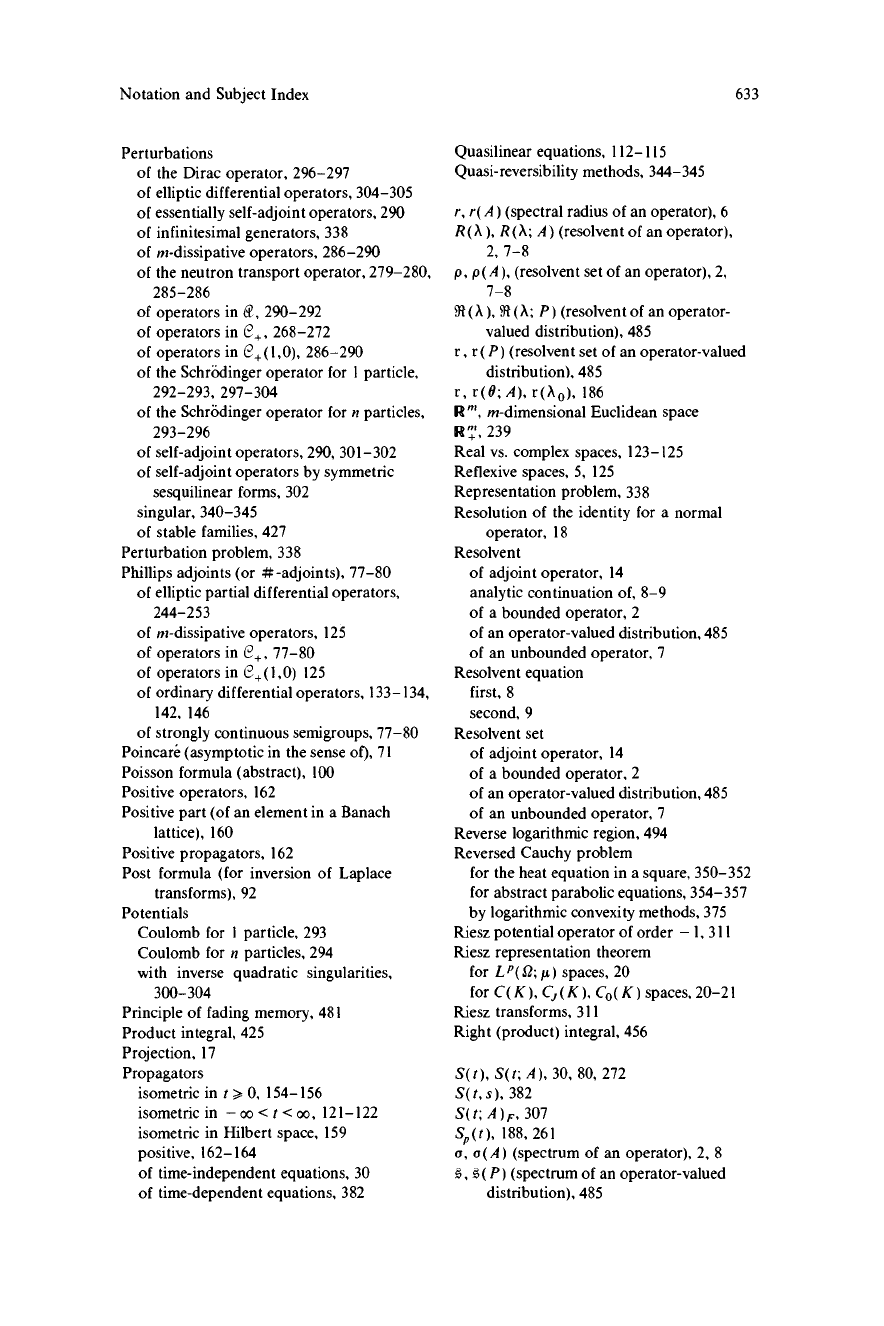
Notation and Subject Index
Perturbations
of the Dirac operator, 296-297
of elliptic differential operators, 304-305
of essentially self-adjoint operators, 290
of infinitesimal generators, 338
of m-dissipative operators, 286-290
of the neutron transport operator, 279-280,
285-286
of operators in 6, 290-292
of operators in (2, 268-272
of operators in e+(1,0), 286-290
of the Schrodinger operator for I particle,
292-293, 297-304
of the Schrodinger operator for n particles,
293-296
of self-adjoint operators, 290, 301-302
of self-adjoint operators by symmetric
sesquilinear forms, 302
singular, 340-345
of stable families, 427
Perturbation problem, 338
Phillips adjoints (or #-adjoints), 77-80
of elliptic partial differential operators,
244-253
of m-dissipative operators, 125
of operators in e+, 77-80
of operators in (2+(1,0) 125
of ordinary differential operators, 133-134,
142, 146
of strongly continuous semigroups, 77-80
Poincare (asymptotic in the sense of), 71
Poisson formula (abstract), 100
Positive operators, 162
Positive part (of an element in a Banach
lattice), 160
Positive propagators, 162
Post formula (for inversion of Laplace
transforms), 92
Potentials
Coulomb for I particle, 293
Coulomb for n particles, 294
with inverse quadratic singularities,
300-304
Principle of fading memory, 481
Product integral, 425
Projection, 17
Propagators
isometric in t > 0, 154-156
isometric in - oo < t < oo, 121-122
isometric in Hilbert space, 159
positive, 162-164
of time-independent equations, 30
of time-dependent equations, 382
633
Quasilinear equations, 112-115
Quasi-reversibility methods, 344-345
r, r(A) (spectral radius of an operator), 6
R (X), R (A; A) (resolvent of an operator),
2, 7-8
p, p (A), (resolvent set of an operator), 2,
7-8
R (X), 91(A; P) (resolvent of an operator-
valued distribution), 485
r, r ( P) (resolvent set of an operator-valued
distribution), 485
r, r(O; A), r(X0), 186
R"', m-dimensional Euclidean space
R'+, 239
Real vs. complex spaces, 123-125
Reflexive spaces, 5, 125
Representation problem, 338
Resolution of the identity for a normal
operator, 18
Resolvent
of adjoint operator, 14
analytic continuation of, 8-9
of a bounded operator, 2
of an operator-valued distribution, 485
of an unbounded operator, 7
Resolvent equation
first, 8
second, 9
Resolvent set
of adjoint operator, 14
of a bounded operator, 2
of an operator-valued distribution, 485
of an unbounded operator, 7
Reverse logarithmic region, 494
Reversed Cauchy problem
for the heat equation in a square, 350-352
for abstract parabolic equations, 354-357
by logarithmic convexity methods, 375
Riesz potential operator of order - I, 311
Riesz representation theorem
for LF(Q; µ) spaces, 20
for C(K), Cj(K ), C0(K) spaces, 20-21
Riesz transforms, 311
Right (product) integral, 456
S(t), S(t; A), 30, 80, 272
S(t,s), 382
S(t; A) F, 307
SP(t), 188, 261
a, a(A) (spectrum of an operator), 2, 8
P) (spectrum of an operator-valued
distribution), 485
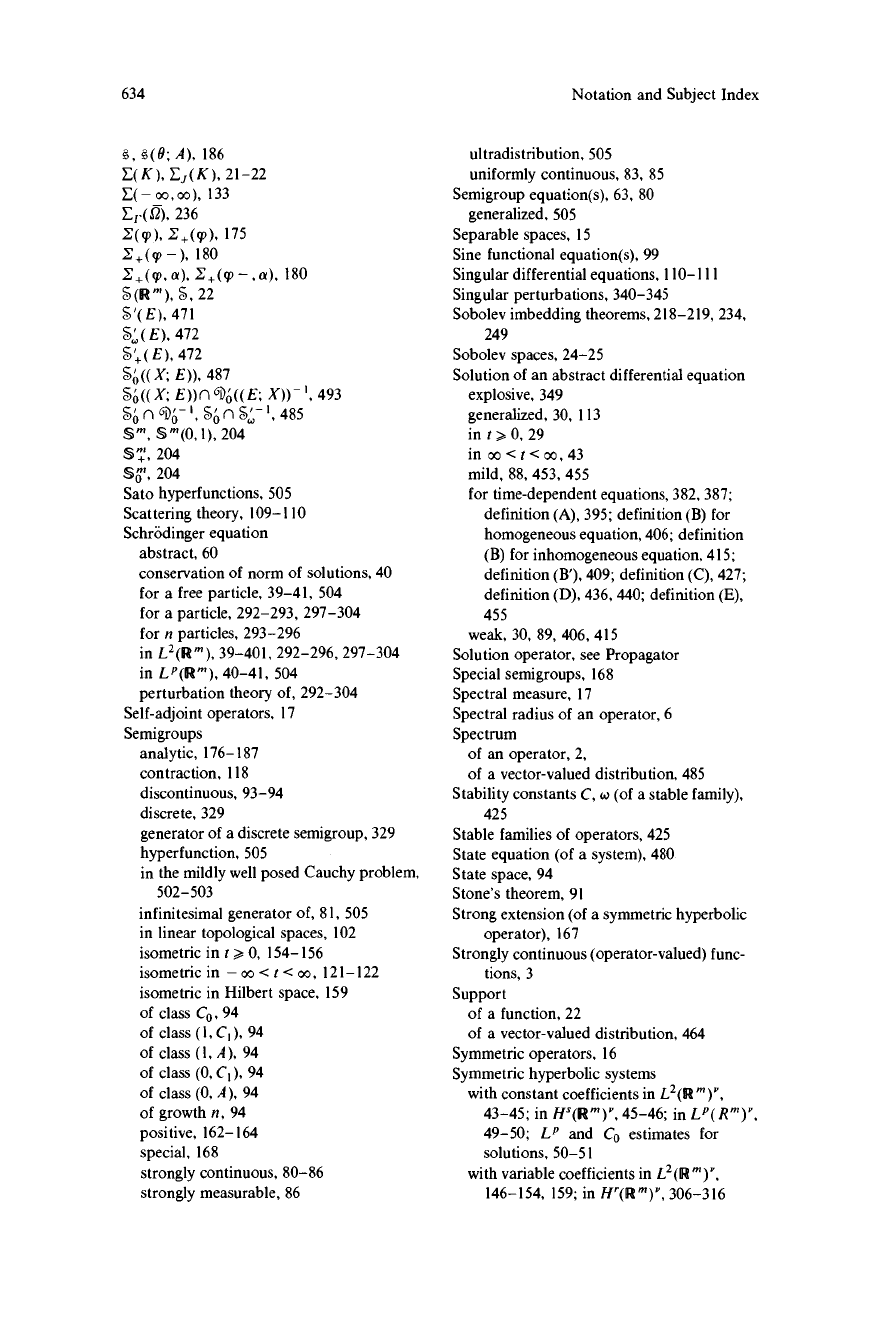
634
, (O; A), 186
E(K),
E,,(K), 21-22
E(-oo,oo), 133
236
E(9p), E+(q ), 175
E+(rp-), 180
E+(92, a), E+(9p - a). 180
S(R"'), S, 22
5'(E), 471
',(E), 472
S +(E ), 472
50'((X;
E)), 487
5o((X; E))n 6D ,((E; X))-', 493
So n GD I, Son
485
S' , S"(0, I), 204
S
204
Si", 204
Sato hyperfunctions, 505
Scattering theory, 109-110
Schrodinger equation
abstract, 60
conservation of norm of solutions, 40
for a free particle, 39-41, 504
for a particle, 292-293, 297-304
for n particles, 293-296
in L2(Rm), 39-401, 292-296, 297-304
in LP(R'"), 40-41, 504
perturbation theory of, 292-304
Self-adjoint operators, 17
Semigroups
analytic, 176-187
contraction, 118
discontinuous, 93-94
discrete, 329
generator of a discrete semigroup, 329
hyperfunction, 505
in the mildly well posed Cauchy problem,
502-503
infinitesimal generator of, 81, 505
in linear topological spaces, 102
isometric in t > 0, 154-156
isometric in - oo < t < oo, 121-122
isometric in Hilbert space, 159
of class Co, 94
of class (1, C1 ), 94
of class (1, A), 94
of class (0, C1 ), 94
of class (0, A), 94
of growth n, 94
positive, 162-164
special, 168
strongly continuous, 80-86
strongly measurable, 86
Notation and Subject Index
ultradistribution, 505
uniformly continuous, 83, 85
Semigroup equation(s), 63, 80
generalized, 505
Separable spaces, 15
Sine functional equation(s), 99
Singular differential equations, 110-111
Singular perturbations, 340-345
Sobolev imbedding theorems, 218-219, 234,
249
Sobolev spaces, 24-25
Solution of an abstract differential equation
explosive, 349
generalized, 30, 113
in t > 0, 29
inoo<t<oo,43
mild, 88, 453, 455
for time-dependent equations, 382, 387;
definition (A), 395; definition (B) for
homogeneous equation, 406; definition
(B) for inhomogeneous equation, 415;
definition (B'), 409; definition (C), 427;
definition (D), 436, 440; definition (E),
455
weak, 30, 89, 406, 415
Solution operator, see Propagator
Special semigroups, 168
Spectral measure, 17
Spectral radius of an operator, 6
Spectrum
of an operator, 2,
of a vector-valued distribution, 485
Stability constants C, w (of a stable family),
425
Stable families of operators, 425
State equation (of a system), 480
State space, 94
Stone's theorem, 91
Strong extension (of a symmetric hyperbolic
operator), 167
Strongly continuous (operator-valued) func-
tions, 3
Support
of a function, 22
of a vector-valued distribution, 464
Symmetric operators, 16
Symmetric hyperbolic systems
with constant coefficients in L2(R
43-45; in H `(R')° 45-46; in LP(Rm)°
49-50; LP and Co estimates for
solutions, 50-51
with variable coefficients in L2(R"
146-154, 159; in H'(R'")°, 306-316
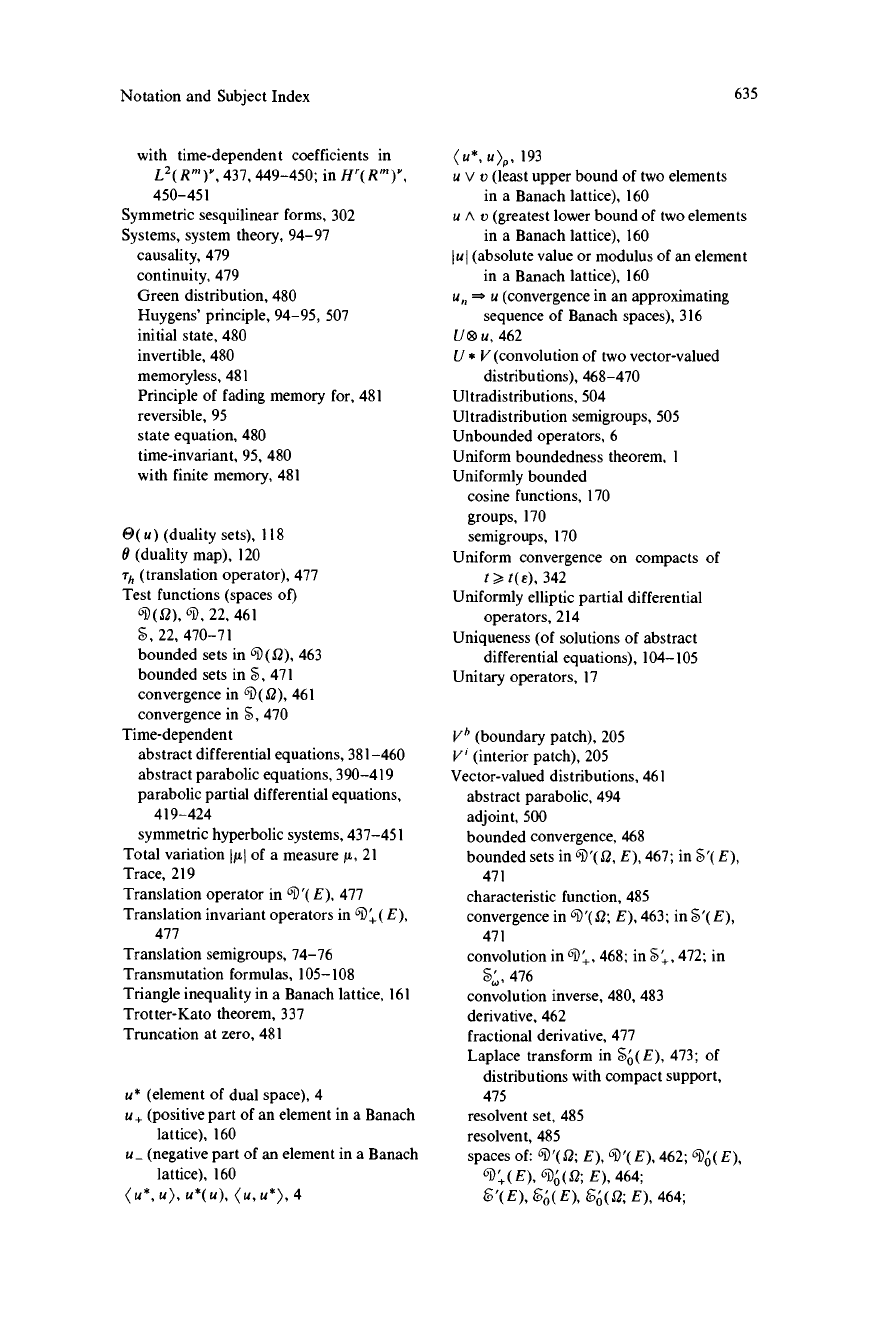
Notation and Subject Index
with time-dependent coefficients in
L2(R"')`, 437, 449-450; in H'(R')',
450-451
Symmetric sesquilinear forms, 302
Systems, system theory, 94-97
causality, 479
continuity, 479
Green distribution, 480
Huygens' principle, 94-95, 507
initial state, 480
invertible, 480
memoryless, 481
Principle of fading memory for, 481
reversible, 95
state equation, 480
time-invariant, 95, 480
with finite memory, 481
©(u) (duality sets), 118
9 (duality map), 120
Th (translation operator), 477
Test functions (spaces of)
6 (Q),6,22,461
5, 22, 470-71
bounded sets in' (d2), 463
bounded sets in 5, 471
convergence in 6D(Q), 461
convergence in 5, 470
Time-dependent
abstract differential equations, 381-460
abstract parabolic equations, 390-419
parabolic partial differential equations,
419-424
symmetric hyperbolic systems, 437-451
Total variation Ij
of a measure µ, 21
Trace, 219
Translation operator in 6 '(E), 477
Translation invariant operators in G1 +(E),
477
Translation semigroups, 74-76
Transmutation formulas, 105-108
Triangle inequality in a Banach lattice, 161
Trotter-Kato theorem, 337
Truncation at zero, 481
u* (element of dual space), 4
u+ (positive part of an element in a Banach
lattice), 160
u - (negative part of an element in a Banach
lattice), 160
(u*, u), u*(u), (u, u*), 4
635
(u*, u)P, 193
u V v (least upper bound of two elements
in a Banach lattice), 160
u A v (greatest lower bound of two elements
in a Banach lattice), 160
uI (absolute value or modulus of an element
in a Banach lattice), 160
U11 = u (convergence in an approximating
sequence of Banach spaces), 316
U®u, 462
U * V (convolution of two vector-valued
distributions), 468-470
Ultradistributions, 504
Ultradistribution semigroups, 505
Unbounded operators, 6
Uniform boundedness theorem, I
Uniformly bounded
cosine functions, 170
groups, 170
semigroups, 170
Uniform convergence on compacts of
t >_ t(e), 342
Uniformly elliptic partial differential
operators, 214
Uniqueness (of solutions of abstract
differential equations), 104-105
Unitary operators, 17
Vh (boundary patch), 205
V' (interior patch), 205
Vector-valued distributions, 461
abstract parabolic, 494
adjoint, 500
bounded convergence, 468
bounded sets in 6D'(2, E), 467; in 5'(E),
471
characteristic function, 485
convergence in 6D'(12; E), 463; in 5'(E),
471
convolution in 6D,, 468; in S+, 472; in
S.,476
convolution inverse, 480, 483
derivative, 462
fractional derivative, 477
Laplace transform in So(E), 473; of
distributions with compact support,
475
resolvent set, 485
resolvent, 485
spaces
of: 6'(12; E), 61'(E), 462; 61 o(E),
6D+(E), 6Do(Q; E), 464;
6;'(E), 6o(E),
E), 464;
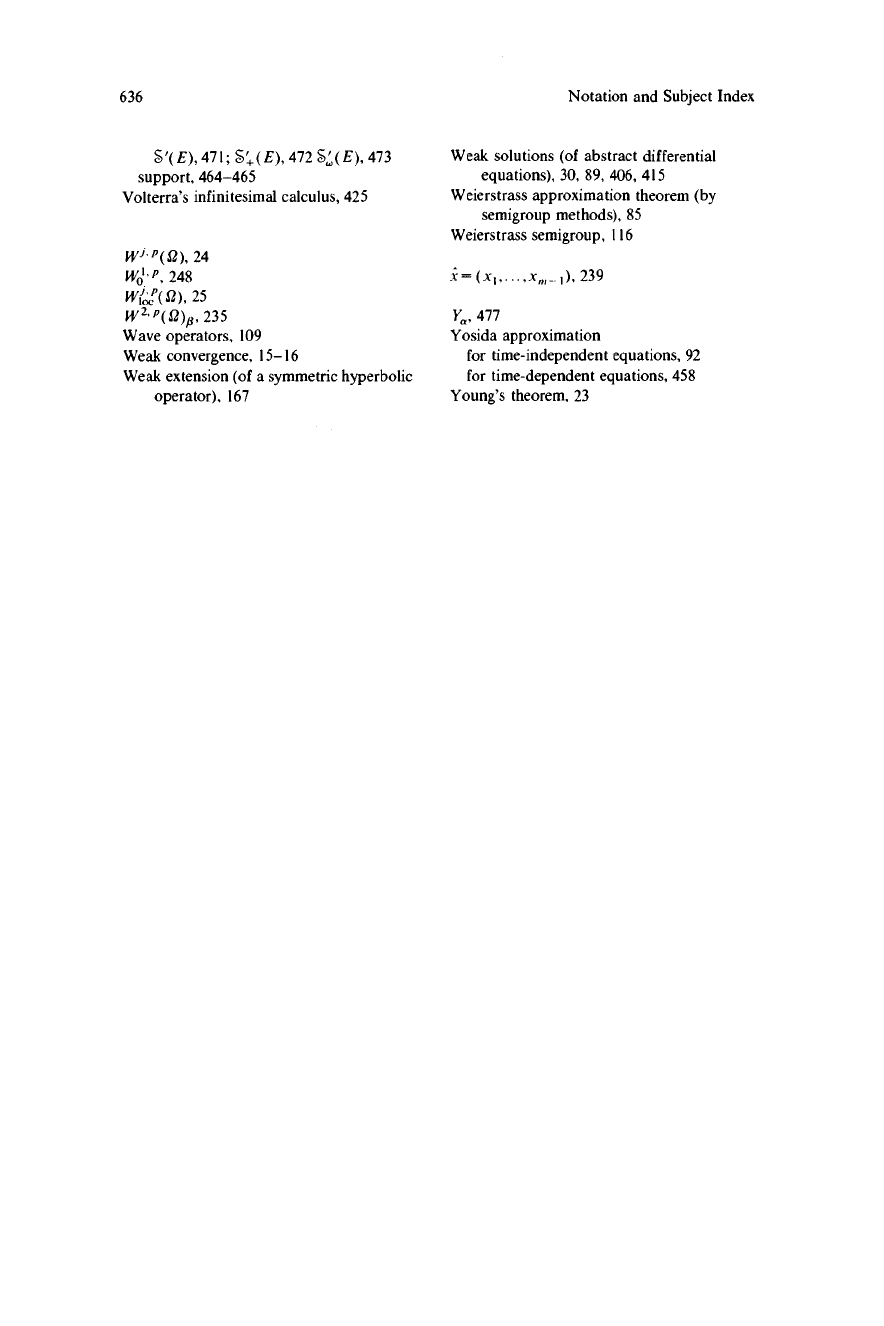
636
S'(E), 471; 5,(E), 472 SL(E), 473
support,
464-465
Volterra's infinitesimal calculus, 425
W''P(2), 24
Wo °, 248
W (S7), 25
W2 P(12)p 235
Wave operators, 109
Weak convergence, 15-16
Weak extension (of a symmetric hyperbolic
operator), 167
Notation and Subject Index
Weak solutions (of abstract differential
equations), 30, 89, 406, 415
Weierstrass approximation theorem (by
semigroup methods), 85
Weierstrass semigroup, 116
s=(xl,...,x,,,_.1), 239
Y, 477
Yosida approximation
for time-independent equations, 92
for time-dependent equations, 458
Young's theorem, 23
